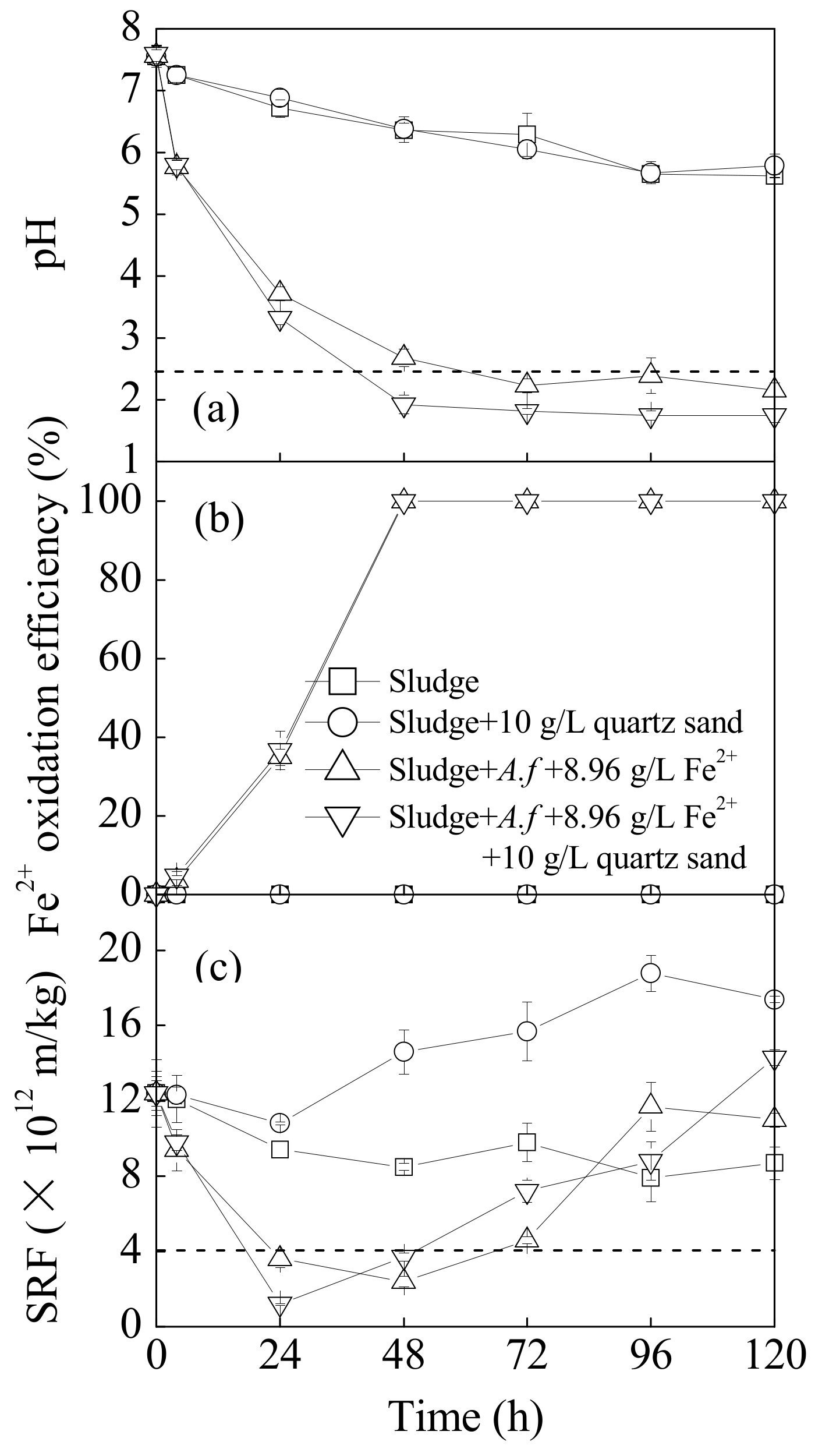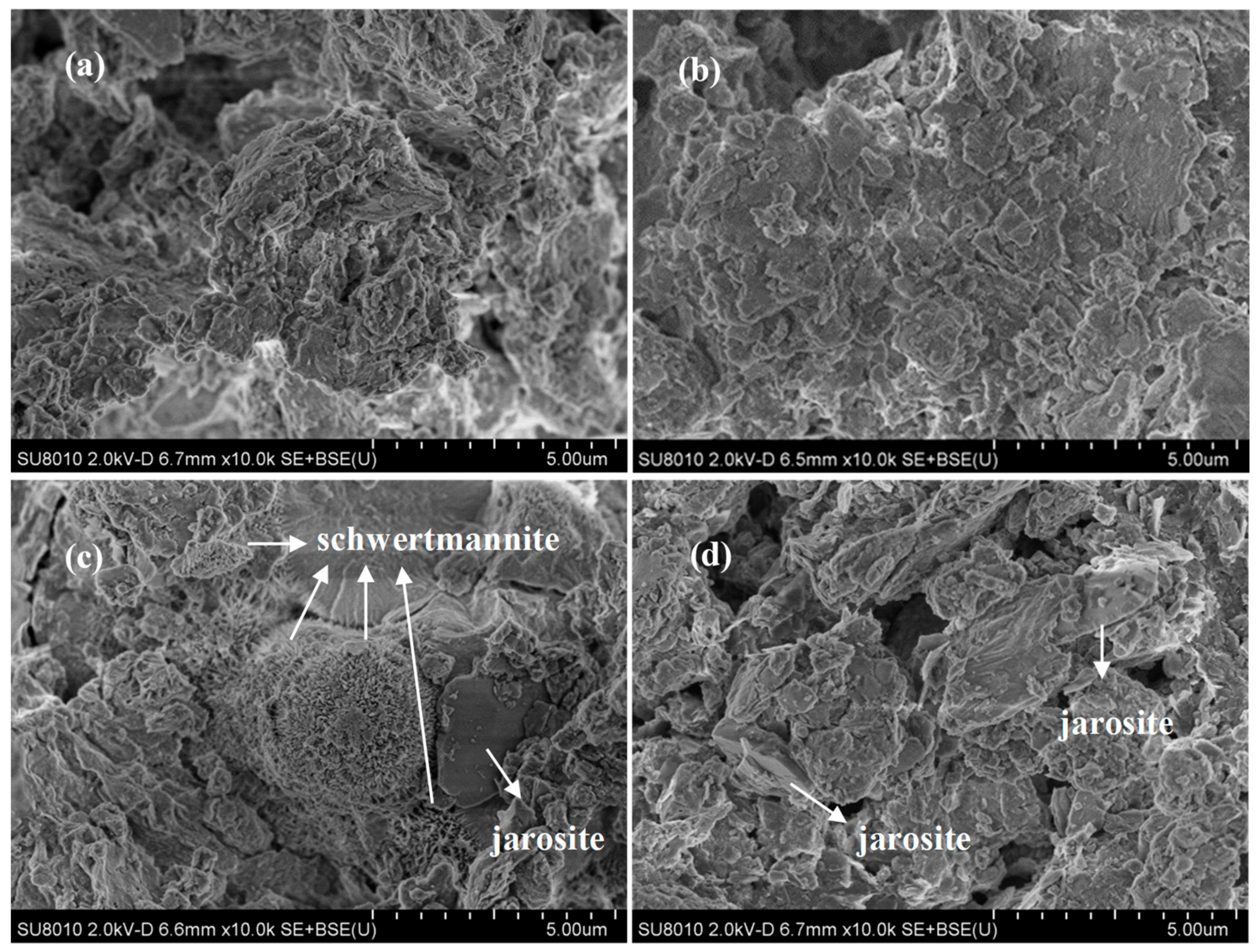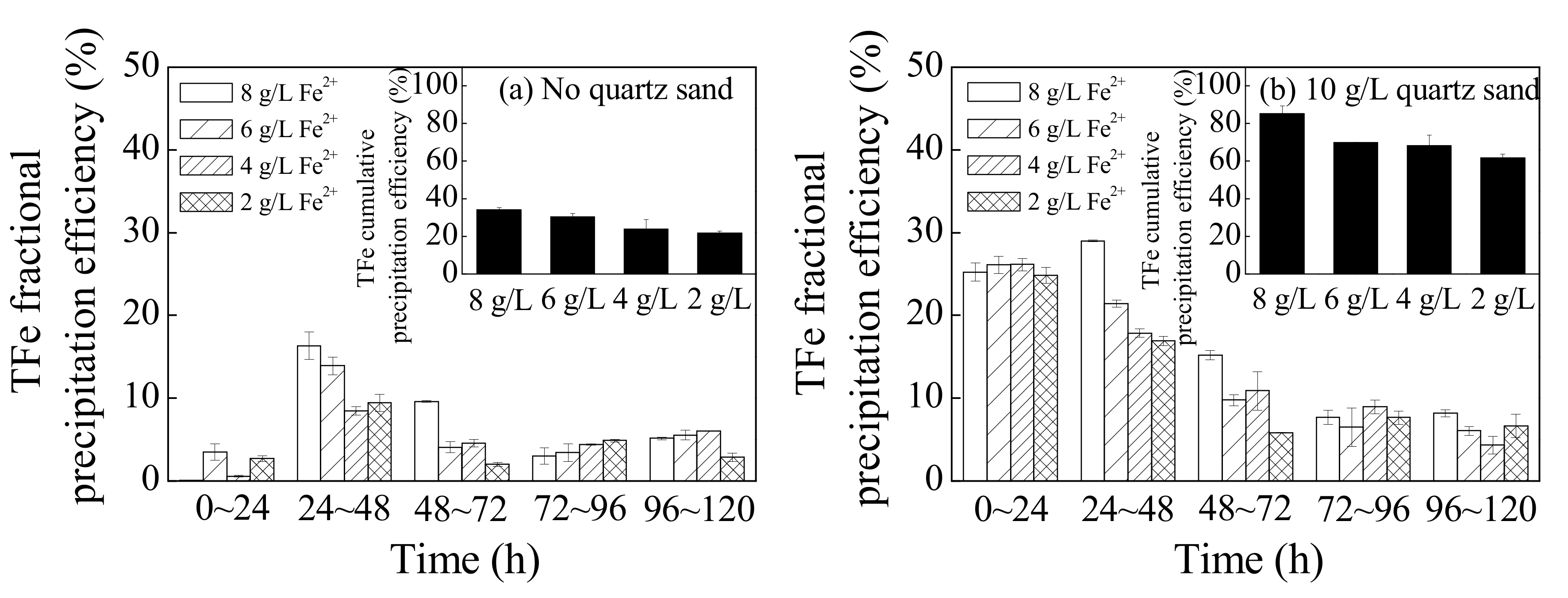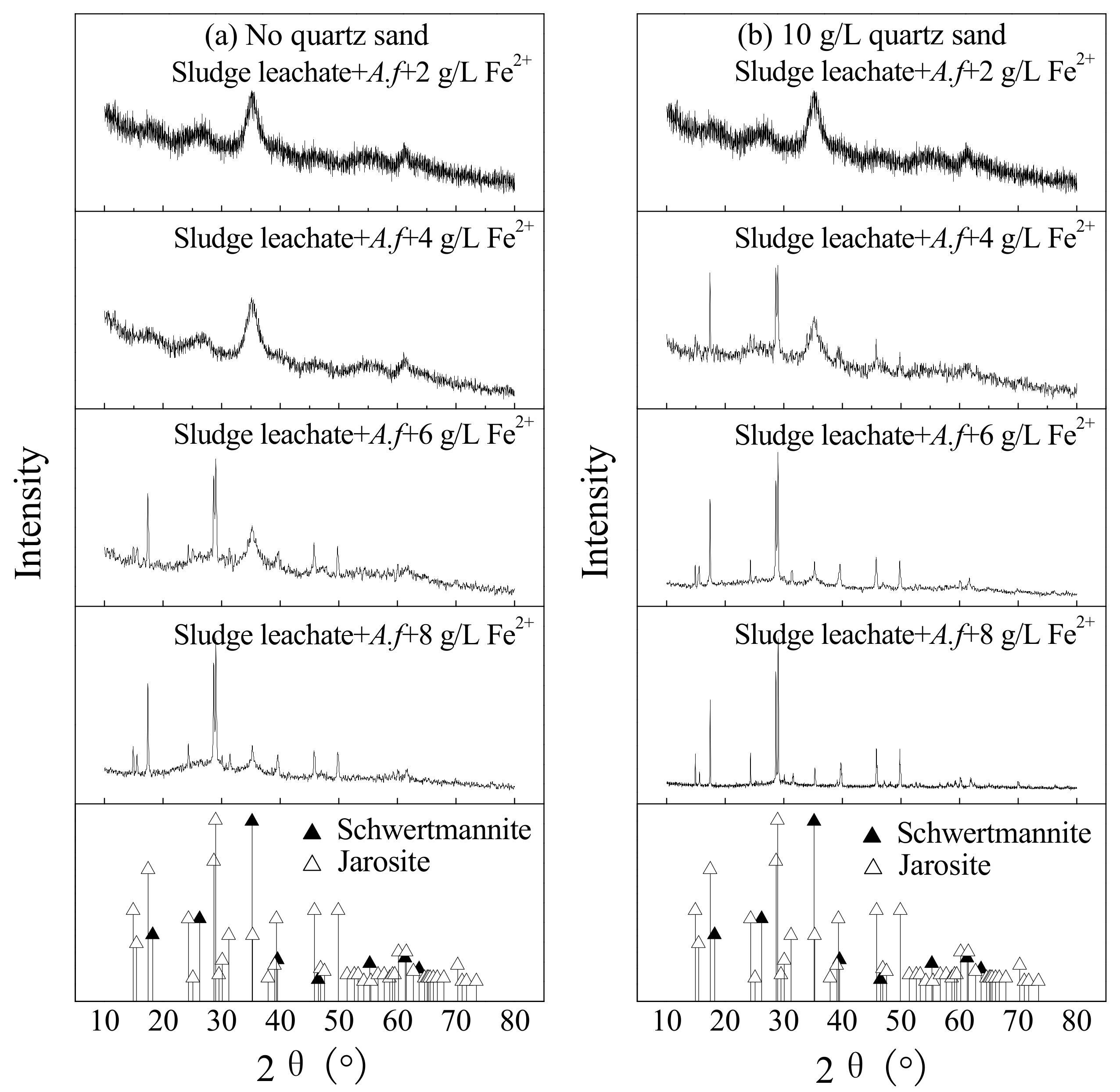The Synthesis of Secondary Iron Minerals Induced by Quartz Sand during the Bioleaching Process Improves the Dewaterability of Municipal Sewage Sludge
Abstract
:1. Introduction
2. Materials and Methods
2.1. Municipal Sewage Sludge Sample and Quartz Sand
2.2. Preparation of A. ferrooxidans LX5 Inoculum
2.3. The Influence of Quartz Sand on the Dewaterability of Sludge in the Bioleaching System Mediated by A. ferrooxidans LX5
2.4. The Influence of Quartz Sand on the Formation of Secondary Iron Minerals in the Bioleaching System Mediated by A. ferrooxidans LX5
2.5. Analytical Methods
2.6. Statistical Analysis
3. Results and Discussion
3.1. The Influence of Quartz Sand on the pH, Oxidation Efficiency of Fe2+, SRF in Sludge Bioleaching System
3.2. The Influence of Quartz Sand on the Formation of Secondary Iron Minerals in the Bioleaching System Mediated by A. Ferrooxidans LX5
3.2.1. The Influence of Quartz Sand on the pH, Concentrations of Fe2+ and Fe3+ in the Bioleaching System Mediated by A. Ferrooxidans LX5
3.2.2. The Influence of Quartz Sand on the Precipitation of TFe in the Bioleaching System Mediated by A. Ferrooxidans LX5
3.2.3. The Influence of Quartz Sand on the Synthesis of Secondary Minerals in the Bioleaching System Mediated by A. Ferrooxidans LX5
4. Conclusions
Author Contributions
Funding
Acknowledgments
Conflicts of Interest
References
- Zhou, L.X.; Fang, D.; Wang, S.M.; Wong, J.W.C.; Wang, D.Z. Bioleaching of Cr from tannery sludge: the effects of initial acid addition and recycling of acidified bioleached sludge. Environ. Technol. 2005, 26, 277–284. [Google Scholar] [CrossRef] [PubMed]
- Tyagi, R.D.; Sreekrishnan, T.R.; Blais, J.F.; Surampalli, R.Y.; Campbell, P.G.C. Effect of dissolved oxygen on sludge acidification during the SSDML process. Water Air Soil Pollut. 1998, 102, 139–155. [Google Scholar] [CrossRef]
- Zhou, L.X.; Zhou, S.G.; Wang, S.M.; Fang, D.; Wang, D.Z. Cr removal and improving the settling and dehydrating capability from tannery sludge simultaneously through bioleaching approach. Acta Sci. Circum. 2004, 6, 1014–1020. [Google Scholar]
- Wang, D.Z.; Zhou, L.X.; He, F. Studies on the enhancement of dehydration property of tannery sludge by bioleaching technique. China Environ. Sci. 2006, 26, 67–71. [Google Scholar]
- Song, X.W.; Zhou, L.X. The influence of bioleaching on dewaterability of municipal sewage sludge. Acta Sci. Circum. 2008, 28, 2012–2017. [Google Scholar]
- Chen, H.; Zhou, L.X.; Li, C. The removal of Cr from tannery sludge by bioleaching in air-lift reactor: A pilot study. Environ. Sci. 2007, 28, 2046–2051. [Google Scholar]
- Liu, F.W.; Zhou, L.X.; Zhou, J.; Song, X.W.; Wang, D.Z. Improvement of sludge dewaterability and removal of sludge-borne metals by bioleaching at optimum pH. J. Hazard. Mater. 2012, 221, 170–177. [Google Scholar] [CrossRef] [PubMed]
- Zhou, J.; Zheng, G.; Wong, J.W.; Zhou, L. Degradation of inhibitory substances in sludge by Galactomyces sp. Z3 and the role of its extracellular polymeric substances in improving bioleaching. Bioresour. Technol. 2013, 132, 217–223. [Google Scholar] [CrossRef] [PubMed]
- Murugesan, K.; Ravindran, B.; Selvam, A.; Kurade, M.B.; Yu, S.M.; Wong, J.W. Enhanced dewaterability of anaerobically digested sewage sludge using Acidithiobacillus ferrooxidans culture as sludge conditioner. Bioresour. Technol. 2014, 169, 374–379. [Google Scholar] [CrossRef] [PubMed]
- Wong, J.W.C.; Xiang, L.; Gu, X.Y.; Zhou, L.X. Bioleaching of heavy metals from anaerobically digested sewage sludge using FeS2 as an energy source. Chemosphere 2004, 55, 101–107. [Google Scholar] [CrossRef] [PubMed]
- Xiang, L.; Chan, L.C.; Wong, J.W.C. Removal of heavy metals from anaerobically digested sewage sludge by isolated indigenous iron-oxidizing bacteria. Chemosphere 2000, 41, 283–287. [Google Scholar] [CrossRef]
- Wang, H.M.; Min, X.B.; Chai, L.Y.; Shu, Y.D. Biological preparation and application of poly-ferric sulfate flocculant. Trans. Nonferrous Met. Soc. China 2011, 21, 2542–2547. [Google Scholar] [CrossRef]
- Liao, Y.; Zhou, L.; Bai, S.; Liang, J.; Wang, S. Occurrence of biogenic schwertmannite in sludge bioleaching environments and its adverse effect on solubilization of sludge-borne metals. Appl. Geochem. 2009, 24, 1739–1746. [Google Scholar] [CrossRef]
- Zhou, J.; Zhou, L.; Liu, F.; Zheng, C.; Deng, W. Transformation of heavy metals and the formation of secondary iron minerals during pig manure bioleaching by the co-inoculation acidophilic thiobacillus. Environ. Technol. 2012, 33, 2553–2560. [Google Scholar] [CrossRef] [PubMed]
- Control Standards of Pollutants in Sludge for Agricultural Use; GB 4284-2018; Inspection and Quarantine of the People’s Republic of China: Beijing, China, 2018.
- Guo, G.H.; Chen, T.B.; Yang, J.; Zheng, G.; Ding, G. Regional distribution characteristics and variation of heavy metals in sewage sludge of China. Acta Sci. Circum. 2014, 34, 2455–2461. [Google Scholar]
- Sasaki, K.; Konno, H. Morphology of jarosite-group compounds precipitated from biologically and chemically oxidized Fe ions. Can. Mineral. 2000, 38, 45–56. [Google Scholar] [CrossRef]
- Karamanev, D.G. Model of the biofilm structure of Thiobacillus ferrooxidans. J. Biotechnol. 1991, 20, 51–64. [Google Scholar] [CrossRef]
- Jensen, A.B.; Webb, C. Ferrous sulphate oxidation using Thiobacillus ferrooxidans: A review. Process Biochem. 1995, 30, 225–236. [Google Scholar] [CrossRef]
- Dutrizac, J.E. The effect of seeding on the rate of precipitation of ammonium jarosite and sodium jarosite. Hydrometallurgy 1996, 42, 293–312. [Google Scholar] [CrossRef]
- Wang, M.; Zhou, L.X. The removal of soluble ferrousiron in acid mine drainage (AMD) through the formation of biogenic iron oxyhydrosulfate precipitates facilitated by diatomite, quartz sand and potassium. Acta Petrol. Mineral. 2011, 30, 1031–1038. [Google Scholar]
- Tichý, R.; Janssen, A.; Grotenhuis, J.T.C.; Lettinga, G.; Rulkens, W.H. Possibilities for using biologically-produced sulphur for cultivation of Thiobacillus with respect to bioleaching processes. Bioresour. Technol. 1994, 48, 221–227. [Google Scholar] [CrossRef]
- American Public Health Association. APHA: Standard Methods for the Examination of Water and Wastewater; American Public Health Association: Washington, DC, USA, 2005. [Google Scholar]
- Liu, F.W.; Gao, S.Y.; Wang, M.; Yu, H.Y.; Cui, C.H.; Zhou, L.X. Effect of KOH on the formation of biogenic secondary iron minerals in iron- and sulfate-rich acidic environment. Acta Sci. Circum. 2015, 35, 476–483. [Google Scholar]
- Loan, M.; Richmond, W.R.; Parkinson, G.M. On the crystal growth of nanoscale schwertmannite. J. Cryst. Growth 2005, 275, 1875–1881. [Google Scholar] [CrossRef]
- Jönsson, J.; Persson, P.; Sjöberg, S.; Lövgren, L. Schwertmannite precipitated from acid mine drainage: phase transformation, sulfate release and surface properties. Appl. Geochem. 2005, 20, 179–191. [Google Scholar] [CrossRef]
- Šubrt, J.; Boháček, J.; Štengl, V.; Grygar, T.; Bezdička, P. Uniform particles with a large surface area formed by hydrolysis of Fe2(SO4)3 with Urea. Mater. Res. Bull. 1999, 34, 905–914. [Google Scholar] [CrossRef]
- Hongfu, S.; Fenghua, Z.; Zhiyuan, C. The mineral Schwertmannite found in China and its characteristics. Acta Mineral. Sin. 2006, 26, 38–42. [Google Scholar]
- Singer, P.C.; Stumm, W. Acidic mine drainage: The rate determining step. Science 1970, 167, 1121–1123. [Google Scholar] [CrossRef] [PubMed]
- Umita, T. Biological mine drainage treatment. Resour. Conserv. Recycl. 1996, 16, 179–188. [Google Scholar] [CrossRef]
- Bosecker, K. Bioleaching: Metal solubilization by microorganisms. FEMS. Microbiol. Rev. 1997, 20, 591–604. [Google Scholar] [CrossRef]
- Harahuc, L.; Lizama, H.M.; Suzuki, I. Selective inhibition of the oxidation of ferrous iron or sulfur in Thiobacillus ferrooxidans. Appl. Environ. Microbl. 2000, 66, 1031–1037. [Google Scholar] [CrossRef]
- Bai, S.Y.; Liang, J.R.; Zhou, L.X. Effects of iron/potassium molar ratio on mass of biogenic Fe(III) hydroxysulfate precipitates in the FeSO4-K2SO4-H2O system and their environmental implications. Acta Sci. Circum. 2010, 30, 1601–1607. [Google Scholar]
- Regenspurg, S.; Brand, A.; Peiffer, S. Formation and stability of schwertmannite in acid mining lakes 1. Geochim. Cosmochim. Acta 2004, 68, 1185–1197. [Google Scholar] [CrossRef]
- International Center for Diffraction Data. JCPDS-Mineral Powder Diffraction Files; International Center for Diffraction Data: Swarthmore, PA, USA, 2002. [Google Scholar]





© 2018 by the authors. Licensee MDPI, Basel, Switzerland. This article is an open access article distributed under the terms and conditions of the Creative Commons Attribution (CC BY) license (http://creativecommons.org/licenses/by/4.0/).
Share and Cite
Ma, Y.; Wang, H.; Song, Y.; Wu, Y.; Guo, Z. The Synthesis of Secondary Iron Minerals Induced by Quartz Sand during the Bioleaching Process Improves the Dewaterability of Municipal Sewage Sludge. Minerals 2018, 8, 419. https://doi.org/10.3390/min8100419
Ma Y, Wang H, Song Y, Wu Y, Guo Z. The Synthesis of Secondary Iron Minerals Induced by Quartz Sand during the Bioleaching Process Improves the Dewaterability of Municipal Sewage Sludge. Minerals. 2018; 8(10):419. https://doi.org/10.3390/min8100419
Chicago/Turabian StyleMa, Yingying, Heru Wang, Yongwei Song, Yiqian Wu, and Zehao Guo. 2018. "The Synthesis of Secondary Iron Minerals Induced by Quartz Sand during the Bioleaching Process Improves the Dewaterability of Municipal Sewage Sludge" Minerals 8, no. 10: 419. https://doi.org/10.3390/min8100419
APA StyleMa, Y., Wang, H., Song, Y., Wu, Y., & Guo, Z. (2018). The Synthesis of Secondary Iron Minerals Induced by Quartz Sand during the Bioleaching Process Improves the Dewaterability of Municipal Sewage Sludge. Minerals, 8(10), 419. https://doi.org/10.3390/min8100419




